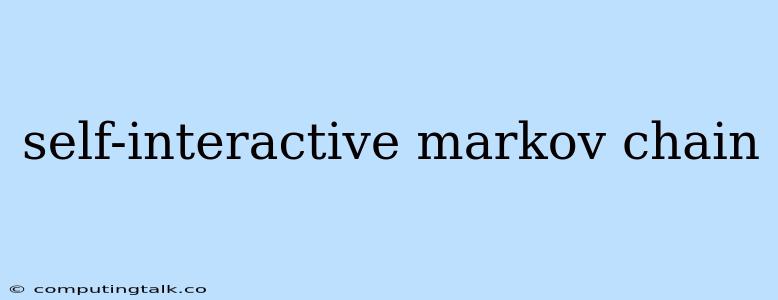A self-interactive Markov chain is a powerful tool for generating text, music, and other creative content. It's a type of Markov chain that can learn from its own outputs, making it capable of producing increasingly complex and interesting results over time.
What is a Markov Chain?
At its core, a self-interactive Markov chain is a Markov chain, which is a mathematical model that describes a sequence of events where the probability of each event depends only on the state of the previous event. Imagine predicting the next word in a sentence based solely on the previous word. This is a simple example of how a Markov chain works.
How Does a Self-Interactive Markov Chain Work?
The "self-interactive" part of the name refers to the chain's ability to learn from its own outputs. Here's how it works:
-
Initialization: The chain starts with an initial set of states and transition probabilities. These probabilities define the likelihood of moving from one state to another.
-
Generation: The chain generates a sequence of states based on these probabilities. This could be a sequence of words, musical notes, or any other type of data.
-
Feedback: The chain then analyzes its output and uses this information to update the transition probabilities. This feedback loop allows the chain to learn from its own creations, refining its ability to generate increasingly interesting results.
The Power of Self-Interaction
The self-interaction feature is what makes a self-interactive Markov chain truly special. By constantly learning from its own outputs, the chain can:
- Improve its consistency: The chain becomes better at generating outputs that are consistent with its previous outputs.
- Develop unique patterns: The chain can discover and exploit patterns in its own output, leading to new and creative results.
- Generate more complex content: The chain can create more complex and interesting content over time, as it learns from its mistakes and successes.
Applications of Self-Interactive Markov Chains
Self-interactive Markov chains have a wide range of applications in various fields, including:
- Text generation: They can be used to create realistic-sounding text, such as dialogue for chatbots or scripts for movies.
- Music composition: They can be used to generate new melodies, harmonies, and even entire compositions.
- Image generation: They can be used to create new images based on existing ones, or to generate entirely new images.
- Game design: They can be used to generate new levels, characters, and other game elements.
- Data analysis: They can be used to analyze data and discover hidden patterns.
Example: Generating Text
Let's take the example of generating text. A self-interactive Markov chain can be trained on a corpus of text, such as a book or a collection of articles. Initially, the chain might produce simple and repetitive sentences. However, as it learns from its own outputs, it will gradually improve its ability to generate more complex and nuanced text.
Considerations and Challenges
While self-interactive Markov chains offer powerful capabilities, there are also some considerations and challenges:
- Overfitting: The chain might become too specific to its training data, failing to generalize well to new situations.
- Control and Predictability: It can be challenging to control the output of a self-interactive Markov chain, which can be unpredictable.
- Computational Complexity: Training and running a self-interactive Markov chain can be computationally intensive.
Conclusion
Self-interactive Markov chains are a fascinating and versatile tool for generating creative content. Their ability to learn from their own outputs makes them capable of producing increasingly complex and interesting results. While there are challenges associated with their implementation, the potential benefits make them an exciting area of ongoing research and development.
Self-interactive Markov chains are a powerful tool for generating text, music, and other creative content. They offer a unique way to explore the creative potential of computer algorithms, opening up new possibilities for artistic expression and data analysis.
